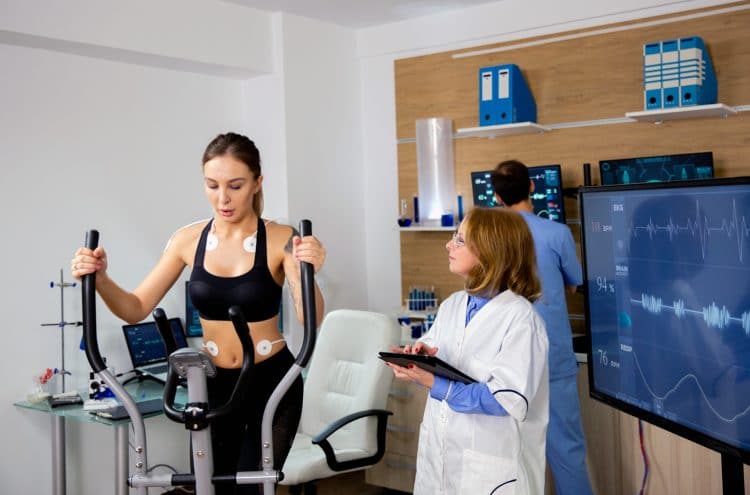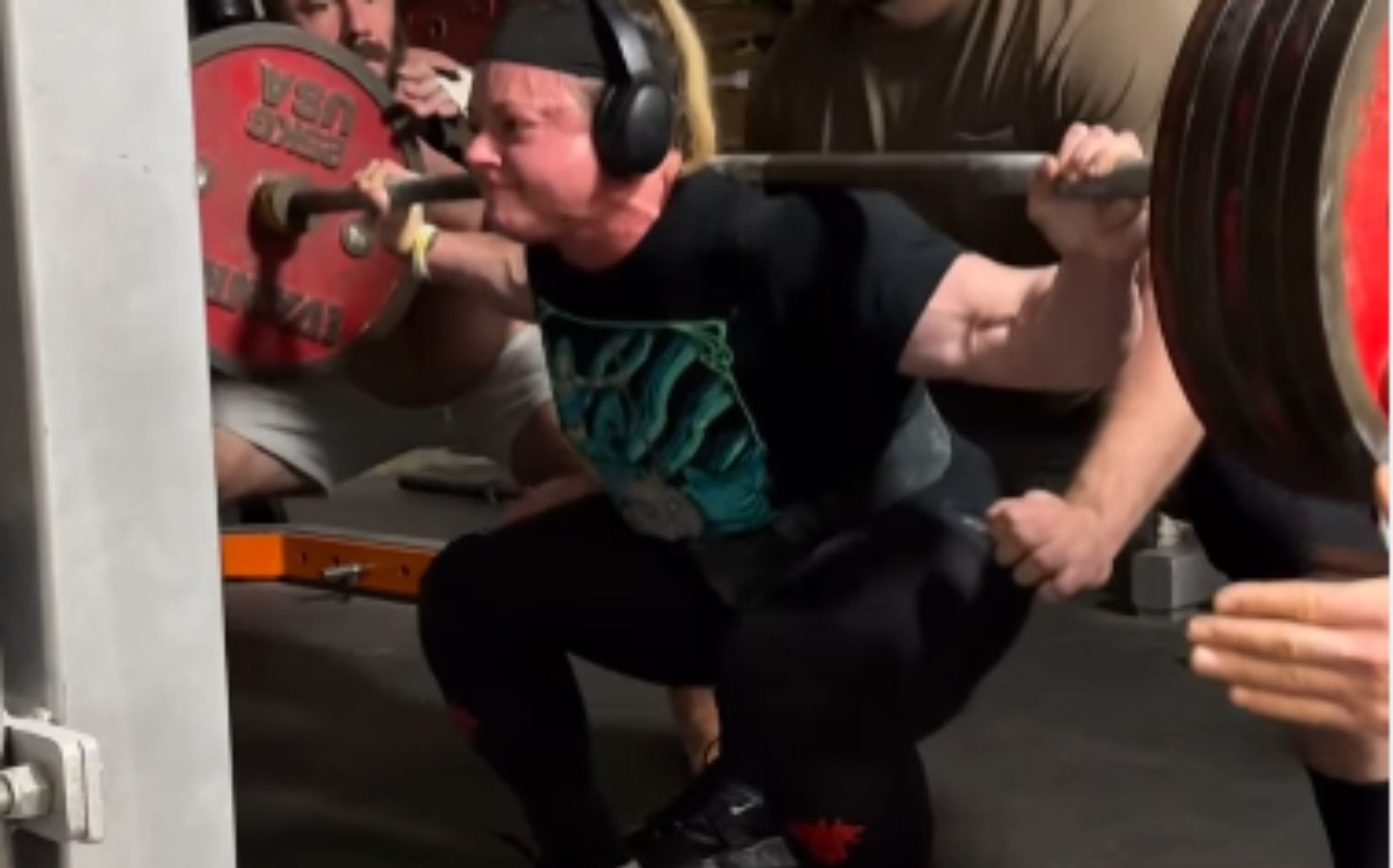As an athlete, you expect your health parameters to be better than average. Your heart rate is a key indicator of your cardiovascular health, and the fitter you are, the lower it should be.
An average resting heart rate for endurance athletes is below 60 beats per minute. A resting heart rate of below 70 beats per minute is considered good for strength and power athletes. Elite athletes can have much lower rates. For example, Cristiano Ronald’s resting rate has been recorded at 32-34 bpm.
As a personal trainer of both strength and endurance athletes, I monitor the resting heart rate as a measure of an athlete’s progress.
In this article, I’ll discuss the average heart rate for athletes, why your heart rate decreases as your fitness level improves, what a good resting heart rate is, and how you can monitor your heart rate.
Average Athlete Heart Rates
Average resting heart rates vary wildly among the general population. A 2020 study involving more than 92,000 people who wore a heart rate monitor over two years showed that average resting heart rates ranged from 40 to 109 beats per minute. The average heart rate was 65 beats per minute. [1]
Level Up Your Fitness: Join our 💪 strong community in Fitness Volt Newsletter. Get daily inspiration, expert-backed workouts, nutrition tips, the latest in strength sports, and the support you need to reach your goals. Subscribe for free!
Keep in mind that this study pulled subjects from the general population. So, it would have included both athletes and non-athletes.
The average heart rate for athletes is considerably lower than among the general population. That’s because regular cardiovascular exercise makes their heart a more efficient and stronger pump.
The average heart rate for a well-conditioned endurance athlete is below 60 beats per minute. The more aerobically fit you are, the lower your average heart rate will be, with high-level athletes getting it down to 30-40 beats per minute.
Strength and power athletes will also have a lower resting heart rate than the average population. However, the difference will not be as pronounced because they are not doing direct cardiovascular endurance training. A strength and power athlete’s average resting heart rate is around 70 beats per minute.
Can An Athlete’s Heart Rate Be Too Low?
Yes, an athlete’s resting heart rate can be too low. If it drops below 30 bpm, the athlete may be in trouble. An extremely low resting heart rate may indicate extreme overtraining or other problems, especially if it is accompanied by dizziness and extreme fatigue, possibly resulting in fainting.
Here are some possible causes of a dangerously low resting heart rate:
- Overtraining: Lack of recovery and rest can result in overtraining. If you do not give your body sufficient time for muscle tissue to rebuild after a workout, you will wear your body down. Lack of quality sleep is another significant factor affecting recovery.
- Dehydration: Dehydration can lead to several sympathetic nervous system reactions, including a reduction in resting heart rate. Lack of water can result in an electrolyte imbalance, affecting the heart’s electrical conduction system.
As a side note, I have witnessed several young wrestlers and boxers who have dehydrated themselves to make weight for a competition. In the process, their resting heart rates have dropped significantly. This puts them in a potentially dangerous situation and is something that should be avoided.
See your doctor immediately if you notice that your resting heart rate has taken a dramatic dip.
What is Athletes’ Heart?
Athlete’s Heart is a colloquial name given to a condition found among some endurance athletes. These people experience heart arrhythmia or irregular heartbeat. It is most common in athletes with a resting heart rate between 35 and 50 beats per minute.
This condition is not considered to be a health hazard.
Recent research suggests athletes may be prone to irregular heartbeat later in life.
A 2014 study published in Nature Communications showed that lifelong endurance athletes with a much slower than normal heart rate had a significantly higher incidence of sinus node (pacemaker) disease later in life and were more likely to have a pacemaker implanted. [2]
The researchers concluded that this tendency results from electrophysiologic changes in the sinus node.
Why Athlete Heart Rates are Lower
Your heart rate measures how many times your heart beats every minute. It is measured as beats per minute (bpm). Your resting heart rate is the number of beats when you are non-active and is best taken when you wake in the morning.
The average resting heart rate for non-athletes ranges between 60-100 bpm. The fitter a person becomes, the lower their heart rate will be. That’s because the cardiovascular system undergoes adaptations that make it more efficient. As a result, your heart doesn’t need to beat as often to supply blood around your body.
Here’s an overview of the changes that make your heart a better pump:
Increased Stroke Volume
The stronger your heart becomes as a result of fitness training, the stronger it will be. This will increase its stroke volume so that it can pump more blood with each beat. As a result, your heart can supply the body with the nutrients and oxygen carried in the blood, which it pumps with fewer beats per minute.
Improved Cardiac Output
Your cardiac output refers to the amount of blood your body can pump per minute. The fitter you are, the higher your cardiac output is. Your heart won’t have to work as hard as a less fit person, leading to a lower heart rate.
Better Stroke Volume Recovery
Stroke volume recovery measures how quickly your heart rate returns to normal after an exercise session. The fitter you are, the better your recovery will be.
Better Oxygen Utilization
As you become more aerobically fit, your muscles can extract oxygen from your blood better. So, your heart will not need to work as hard to supply the amount of oxygen needed compared to a person who is not as fit as you.
Nervous System Activity
There are two complementary nervous systems operating in your body:
- The sympathetic nervous system
- The parasympathetic nervous system
The sympathetic nervous system governs the body’s fight-or-flight response to a stressful situation. It creates a heightened sense of awareness and increases the heart rate. The fitter you are, the lower that heart rate increase will be.
The parasympathetic nervous system acts the opposite, promoting relaxation and a lower heart rate. Fitter people’s parasympathetic system will be more efficient, so your heart rate decreases more quickly after exercise and operates at a lower resting level.
Less Blood Pumped Per Minute
As we get fitter, less blood per minute is required by our muscles to function. This is called your stroke volume. Your cardiac output is a measure of your stroke volume times heart rate. So, as we become fitter, our cardiac output at rest comes down.
The average non-athlete resting cardiac output is about 5.7 liters per minute. Comparatively, the average cardiac output for an endurance-trained athlete is about 4.4 liters per minute. Clearly, the heart that is pumping 5.7 liters is going to have to work a lot harder than the one that is pumping 4.4 liters.
Level Up Your Fitness: Join our 💪 strong community in Fitness Volt Newsletter. Get daily inspiration, expert-backed workouts, nutrition tips, the latest in strength sports, and the support you need to reach your goals. Subscribe for free!
Bigger Heart
Aerobic exercise will make your heart physically bigger. This is often called ‘athlete’s heart’ and mainly results from the increase in the size of cardiac muscle cells known as myocytes. The walls of the heart muscle, especially the left ventricle, also thicken as a result of cardio exercise.
A larger heart allows more blood to flow into it. As a result, it will take fewer beats per minute to meet its cardiac output. An untrained heart will have an average volume of about 860 mL, compared to around 940 mL for an elite athlete.
How Does Age Affect Resting Heart Rate?
Age does not appear to affect the resting heart rate very much once you are an adult. A baby’s resting heart rate may be as high as a hundred beats per minute and can fluctuate quite a bit during childhood. The heart rate stabilizes around the age of 18.
Provided that you can maintain your fitness level, your resting heart rate should be the same in your 20s, 30s, 40s, and beyond.
Of course, the reality is that most people become increasingly unfit as they age. This leads to increased resting heart rate. The point here, though, is that this is not an inevitable age-related decline. It is a lifestyle choice.
It should be noted that your maximum heart rate is affected by age. This is a measure of the maximum number of beats your heart can achieve under maximum exertion.
There are several ways to work out your maximum heart rate. The simplest and most commonly used is to subtract your age from 220.
So, if you are 59 years old, your maximum heart rate would be 161 beats per minute (220-59).
Aerobic training zones are often calculated as a percentage of your maximum heart rate.
Max Heart Rate Calculation for Athletes
The 220 minus your age calculation provides a general guideline for your maximum heart rate. However, it may not be accurate enough for endurance athletes.
A 2010 study by Gulati, et al. showed that the 220 minus your age formula overestimates the maximum heart rate. This study was focused on female subjects and concluded that a more accurate formula is 206 – (0.88 x age). [3]
A 2018 study published in the International Journal of Research in Exercise Physiology used the formula 207 – (0.7 x age) to calculate the maximum heart rate.
This formula was used to calculate target heart rate zones for exercise. When subjects trained at these rates, they were found to be within the correct zone 86% of the time when compared to an exercise stress test. [4]
Track and Field coach Brian Mackenzie has developed a calculator on his website specifically designed for athletes to find their maximum heart rate. It is based on years of observation and study and incorporates several research models.
Go here to use Brian’s calculator or use our Target Heart Rate calculator.
For a more accurate manual formula for athletes to calculate their maximum heart rate, Brian recommends using the following formula — 217 – (0.85 x age).
Elite athletes under the age of 30 should subtract three beats from the answer to arrive at their max HR. Those aged over 50 should add two beats, while those over 55 should add four beats.
Rowers should subtract three points from the total, while cyclists should subtract five beats.
These figures are important because they allow athletes to calculate their target training zones.
Heart Rate Target Training Zones
| Training Zone | Intensity Level | Heart Rate Range |
| Resting | Very Light | 50-60% of Max HR |
| Warm-up | Light | 60-70% of Max HR |
| Fat Burning | Moderate | 70-80% of Max HR |
| Aerobic | Vigorous | 80-90% of Max HR |
| Anaerobic | Near Maximum | 90-95% of Max HR |
| Maximum | Maximum Effort | 95-100% of Max HR |
Related: VO2 Max Calculator: Estimate Maximum Volume of Oxygen
Non-Exercise Factors that Affect Resting Heart Rate
Your level of aerobic fitness isn’t the only thing that affects your resting heart rate. Here are seven other factors that affect average heart rate:
1. Gender
Women tend to have a slightly higher average heart rate than men. One reason for this is that men’s hearts are generally larger, allowing for a greater blood volume. Hormonal changes, including those during menstruation, also play a part.
A 2020 resting heart rate research study confirmed that women have a slightly higher resting heart rate than men. The researchers put this down to women having a lower heart volume. [5]
2. Genetics
Your DNA plays a part in determining your resting heart rate. Some people have a genetic predisposition to a lower resting heart rate.
3. Body Composition
People with higher body fat levels will have a higher resting heart rate than leaner people. The more muscle mass you carry in your body, the more efficiently your muscles will extract oxygen from your blood. As a result, your heart doesn’t have to work as hard to supply the oxygen you need to function.
4. Temperature
The hotter it is, the higher your resting heart rate will be. That’s because your body, including your heart, needs to work harder to keep you cool. By the same token, cold environments will also increase your resting heart rate as the body works overtime to warm itself up.
5. Stress and Anxiety
Emotional factors like stress and anxiety will affect your resting heart rate. Stress brings on the fight or flight response of the sympathetic nervous system, increasing the heart rate.
6. Stimulants
People who drink a lot of coffee or use stimulants as pre-workouts will experience a temporary increase in heart rate. Taking these stimulants in the evening may affect the resting heart rate first thing in the morning.
Wrap Up
The average resting heart rate for an endurance athlete is 50-60 beats per minute. That number is slightly higher for strength and powerlifting athletes, at 60-70 beats per minute.
The more cardiovascular endurance exercises you perform, the stronger and more efficient your heart will be. As a result, it won’t have to beat so many times each minute to pump blood around your body.
Remember that heart rates can fluctuate quite widely due to nonexercise factors, such as genetics, body composition, and temperature. So, it’s a mistake to get fixated on bringing your resting rate down as an indicator of improved performance. It is just one of various variables to assess overall health and fitness levels.
References
- Quer G, Gouda P, Galarnyk M, Topol EJ, Steinhubl SR. Inter- and intraindividual variability in daily resting heart rate and its associations with age, sex, sleep, BMI, and time of year: Retrospective, longitudinal cohort study of 92,457 adults. PLoS One. 2020 Feb 5;15(2):e0227709. doi: 10.1371/journal.pone.0227709. PMID: 32023264; PMCID: PMC7001906.
- D’Souza A, Bucchi A, Johnsen AB, Logantha SJ, Monfredi O, Yanni J, Prehar S, Hart G, Cartwright E, Wisloff U, Dobryznski H, DiFrancesco D, Morris GM, Boyett MR. Exercise training reduces resting heart rate via downregulation of the funny channel HCN4. Nat Commun. 2014 May 13;5:3775. doi: 10.1038/ncomms4775. PMID: 24825544; PMCID: PMC4024745.
- Gulati M, Shaw LJ, Thisted RA, Black HR, Bairey Merz CN, Arnsdorf MF. Heart rate response to exercise stress testing in asymptomatic women: the st. James women take heart project. Circulation. 2010 Jul 13;122(2):130-7. doi:
- Marx, A. J., Porcari, J. P., Doberstein, S., Arney, B. E., Bramwell, S., & Foster, C. (2019). The Accuracy of Heart Rate-Based Zone Training using Predicted versus Measured Maximal Heart Rate. Manuscripts: Volume 14 Number 1 Fall 2018, Keywords: Exercise Prescription, Target Heart Rate, Zone Training. Department of Exercise and Sport Science, University of Wisconsin-La Crosse, La Crosse, WI, USA.10.1161/CIRCULATIONAHA.110.939249. Epub 2010 Jun 28. PMID: 20585008.
- https://www.brianmac.co.uk/maxhr.htm#ref
Article Updates Timeline:
Our editorial team experts constantly update the articles with new information & research, ensuring you always have access to the latest and most reliable information.
January 21, 2024
Written By
Steve Theunissen, PT
Edited By
Editorial Team
Medically Reviewed By
Dr. Malik












